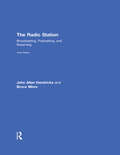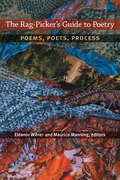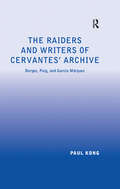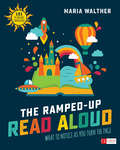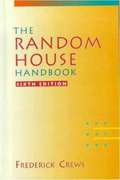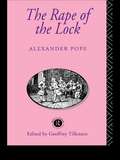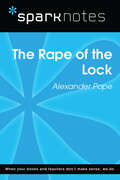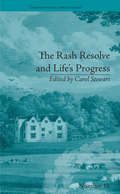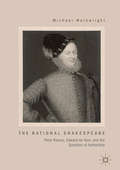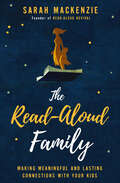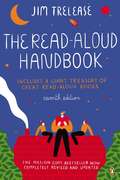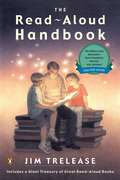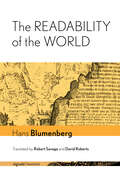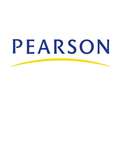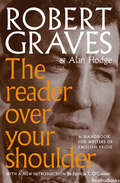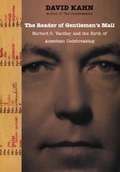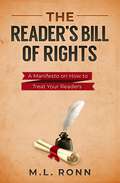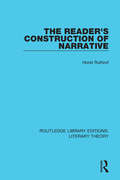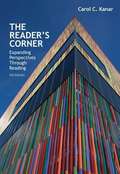- Table View
- List View
The Radio Station: Broadcasting, Podcasting, and Streaming
by Bruce Mims John Allen HendricksThe Radio Station offers a concise and insightful guide to all aspects of radio broadcasting, streaming, and podcasting. This book’s tenth edition continues its long tradition of guiding readers to a solid understanding of who does what, when, and why in a professionally managed station. This new edition explains what "radio" in America has been, where it is today, and where it is going, covering the basics of how programming is produced, financed, delivered and promoted via terrestrial and satellite broadcasting, streaming and podcasting, John Allen Hendricks and Bruce Mims examine radio and its future within a framework of existing and emerging technologies. The companion website is new revised with content for instructors, including an instructors’ manual and test questions. Students will discover an expanded library of audio interviews with leading industry professionals in addition to practice quizzes and links to additional resources.
The Rag-Picker's Guide to Poetry: Poems, Poets, Process
by Maurice Manning Eleanor WilnerThe venture of this inviting collection is to look, from the many vantages that the 35 poets in this eclectic anthology chose to look, at what it was--knowing that a poem can't be conceived in advance of its creation--that helped their poems to emerge or connected them over time. The Rag-Picker's Guide to Poetrypermits an inside view of how poets outwit internal censors and habits of thought, showing how the meticulous and the spontaneous come together in the process of discovery. Within are contained the work and thoughts of: Betty Adcock Joan Aleshire Debra Allbery Elizabeth Arnold David Baker Rick Barot Marianne Boruch Karen Brennan Gabrielle Calvocoressi Michael Collier Carl Dennis Stuart Dischell Roger Fanning Chris Forhan Reginald Gibbons Linda Gregerson Jennifer Grotz Brooks Haxton Tony Hoagland Mark Jarman A. Van Jordan Laura Kasischke Mary Leader Dana Levin James Longenbach Thomas Lux Maurice Manning Heather McHugh Martha Rhodes Alan Shapiro Daniel Tobin Ellen Bryant Voigt Alan Williamson Eleanor Wilner C. Dale Young
The Raiders and Writers of Cervantes' Archive: Borges, Puig, and García Márquez
by Paul KongWithin the context of Miguel de Cervantes Saavedra and his influence on Jorge Luis Borges, Manuel Puig and Gabriel Marquez, Paul Kong brings a variety of theoretical perspectives to bear as he analyzes the concepts of the archive and the manuscript. Setting the stage with an exploration of the intricate and intriguing relationship between the archive and the manuscript, Kong questions the apparently natural association between the two. In the light of Kong's historically contextualized and patient exegesis, the ideological nature of the archive, evident in its charge to serve as a totalizing habitat, stands in contrast with the manuscript that resists attempts to contain it. The playful responses of Borges, Puig and Marquez as they mine the "archive" of Cervantes' works support the anti-colonial dimension of Latin American literature and further problematize the relationship between archive and manuscript. The book concludes with a discussion of the future of archival discourse, especially in the setting of the virtual reality of the Internet and of globalization. Carefully grounded by Kong's close readings and supported by a wealth of astute references and allusions to writers as diverse as Virgil, Wordsworth, and Dickens, The Raiders and Writers of Cervantes' Archive is sure to provoke and intrigue Latin American scholars, narrative theorists, archivists, and those interested in issues related to cultural domination, ideology, and cyberspace.
The Rainbow Quest of Thomas Pynchon
by Douglas A. MackeyLiterary criticism of Thomas Pynchon's famous novel, Gravity's Rainbow.
The Ramped-Up Read Aloud: What to Notice as You Turn the Page
by Maria P. WaltherWhat if each page of a picture book was guaranteed to enhance a child’s reading and writing tenfold? Would you ramp up your read alouds? In this remarkable resource, Maria Walther shares two-page read aloud experiences for 101 picture books that tune you into what to notice, say, and wonder in order to bolster students’ literacy exponentially. The read alouds in this book will help teachers: Foster a strong sense of community Celebrate the written (and illustrated) word Build a foundation for future reading and learning Expand vocabulary (with a focus on Tier 2 words) Support budding writers Spark collaborative conversations Encourage perspective-taking, empathy, and a growth mindset A first grade teacher for decades, Maria is a master of “strategic savoring.” Her lesson design efficiently sparks instructional conversations around the cover illustration, enriching vocabulary words, literary language, and the ideas and themes vital to young learners. Maria arranges the rich fiction and nonfiction titles into chapters that mirror the way primary teachers plan curriculum. Need books tailor made for building community? Teaching literary elements? Comprehension strategies? Foundational and language skills? Inspiring writers? It’s all here and at the ready. Coaching tips on expressive oral reading, strategic seating, uncovering language nuances for EL students, effective questioning and more make the art of sharing books and learning with children do-able for everyone. Teachers, schools, and districts looking to energize your core reading and writing program, search no further: The Ramped-Up Read Aloud delivers a formula for literacy development and a springboard to joy in equal parts.
The Ramped-Up Read Aloud: What to Notice as You Turn the Page
by Maria P. WaltherWhat if each page of a picture book was guaranteed to enhance a child’s reading and writing tenfold? Would you ramp up your read alouds? In this remarkable resource, Maria Walther shares two-page read aloud experiences for 101 picture books that tune you into what to notice, say, and wonder in order to bolster students’ literacy exponentially. The read alouds in this book will help teachers: Foster a strong sense of community Celebrate the written (and illustrated) word Build a foundation for future reading and learning Expand vocabulary (with a focus on Tier 2 words) Support budding writers Spark collaborative conversations Encourage perspective-taking, empathy, and a growth mindset A first grade teacher for decades, Maria is a master of “strategic savoring.” Her lesson design efficiently sparks instructional conversations around the cover illustration, enriching vocabulary words, literary language, and the ideas and themes vital to young learners. Maria arranges the rich fiction and nonfiction titles into chapters that mirror the way primary teachers plan curriculum. Need books tailor made for building community? Teaching literary elements? Comprehension strategies? Foundational and language skills? Inspiring writers? It’s all here and at the ready. Coaching tips on expressive oral reading, strategic seating, uncovering language nuances for EL students, effective questioning and more make the art of sharing books and learning with children do-able for everyone. Teachers, schools, and districts looking to energize your core reading and writing program, search no further: The Ramped-Up Read Aloud delivers a formula for literacy development and a springboard to joy in equal parts.
The Random House Handbook (Sixth Edition)
by Frederick CrewsThe Random House Handbook, Sixth Edition offers a comprehensive guide to writing and style, as well as special applications.
The Rape of the Lock
by Alexander Pope Geoffrey TillotsonFirst published in 1971. Routledge is an imprint of Taylor & Francis, an informa company.
The Rape of the Lock (SparkNotes Literature Guide Series)
by SparkNotesThe Rape of the Lock (SparkNotes Literature Guide) by Alexander Pope Making the reading experience fun! Created by Harvard students for students everywhere, SparkNotes is a new breed of study guide: smarter, better, faster. Geared to what today's students need to know, SparkNotes provides: *Chapter-by-chapter analysis *Explanations of key themes, motifs, and symbols *A review quiz and essay topicsLively and accessible, these guides are perfect for late-night studying and writing papers
The Rash Resolve and Life's Progress: by Eliza Haywood (Chawton House Library: Women's Novels #16)
by Carol StewartEliza Haywood was one of the most popular and versatile writers of the eighteenth century. The two novellas in this edition – The Rash Resolve (1724) and Life’s Progress (1748) – show her developing and adapting her ideas on the subject of passion and romance. Though superficially presented as cautionary tales, Haywood introduces a feminist slant.
The Rational Shakespeare: Peter Ramus, Edward de Vere, and the Question of Authorship
by Michael WainwrightThe Rational Shakespeare: Peter Ramus, Edward de Vere, and the Question of Authorship examines William Shakespeare’s rationality from a Ramist perspective, linking that examination to the leading intellectuals of late humanism, and extending those links to the life of Edward de Vere, Seventeenth Earl of Oxford. The application to Shakespeare’s plays and sonnets of a game-theoretic hermeneutic, an interpretive approach that Ramism suggests but ultimately evades, strengthens these connections in further supporting the Oxfordian answer to the question of Shakespearean authorship.
The Raven and the Whale: The War of Words and Wits in the Era of Poe and Melville
by Perry MillerAnalysis of literary thought in the mid-1800's.
The Read-Aloud Family: Making Meaningful and Lasting Connections with Your Kids
by Sarah MackenzieDiscover practical strategies to make reading aloud a meaningful family ritual.The stories we read--and the conversations we have about them--help shape family traditions, create lifelong memories, and become part of our legacy. Reading aloud not only has the power to change a family--it has the power to change the world. But we all know that connecting deeply with our families can be difficult in our busy, technology-driven society. Reading aloud is one of the best ways to be fully present with our children, even after they can read themselves, but it isn't always easy to do. Discover how to:Prepare your kids for academic success through reading to themDevelop empathy and compassion in your kids through booksFind time to read aloud in the midst of school, sports, and dinner dishesChoose books across a variety of sibling interests and agesMake reading aloud the best part of your family's dayThe Read-Aloud Family also offers age-appropriate book lists from infancy through adolescence. From a toddler's wonder to a teenager's resistance, you will find the inspiration you need to start a read-aloud movement in your own home.
The Read-Aloud Handbook
by Jim TreleaseA New York Times and million copy bestseller, the classic handbook on reading aloud to children--revised and updatedRecommended by "Dear Abby", The New York Times and The Washington Post, for three decades, millions of parents and educators have turned to Jim Trelease's beloved classic to help countless children become avid readers through awakening their imaginations and improving their language skills. Now this new edition of The Read-Aloud Handbook imparts the benefits, rewards, and importance of reading aloud to children of a new generation. Supported by delightful anecdotes as well as the latest research, The Read-Aloud Handbook offers proven techniques and strategies--and the reasoning behind them--for helping children discover the pleasures of reading and setting them on the road to becoming lifelong readers.
The Read-Aloud Handbook: Seventh Edition
by Jim TreleaseThe classic million-copy bestselling handbook on reading aloud to children-revised and updated Recommended by "Dear Abby" upon its first publication in 1982, millions of parents and educators have turned to Jim Trelease’s beloved classic for more than three decades to help countless children become avid readers through awakening their imaginations and improving their language skills. It has also been a staple in schools of education for new teachers. This updated edition of The Read-Aloud Handbook discusses the benefits, the rewards, and the importance of reading aloud to children of a new generation. Supported by delightful anecdotes as well as the latest research (including the good and bad news on digital learning), The Read-Aloud Handbook offers proven techniques and strategies for helping children discover the pleasures of reading and setting them on the road to becoming lifelong readers. .
The Read-aloud Handbook (6th Edition)
by Jim TreleaseFor more than two decades, millions of parents and educators have turned to Jim Trelease's beloved classic to help countless children become avid readers through awakening their imaginations and improving their language skills. Now this new edition of The Read-Aloud Handbook imparts the benefits, rewards, and importance of reading aloud to children of a new generation. Supported by delightful anecdotes as well as the latest research, The Read- Aloud Handbook offers proven techniques and strategies--and the reasoning behind them-- for helping children discover the pleasures of reading and setting them on the road to becoming lifelong readers.
The Readability of the World (signale|TRANSFER: German Thought in Translation)
by Hans BlumenbergThe Readability of the World represents Hans Blumenberg's first extended demonstration of the metaphorological method he pioneered in Paradigms for a Metaphorology. For Blumenberg, metaphors are symptomatic of patterns of thought and feeling that escape conceptual formulation but are nonetheless indispensable, because they allow humans to orient themselves in an otherwise overwhelming world. The Readability of the World applies this method to the idea that the world presents itself as a book. The metaphor of the book of nature has been central to Western interpretations of reality, and Blumenberg traces the evolution of this metaphor from ancient Greek cosmology to the model of the genetic code to access the different expectations of reality that it articulates, reflects, and projects.Writing with equal authority on literature and science, theology and philosophy, ancient metaphysics and twentieth-century biochemistry, Blumenberg advances rich and original interpretations of the thinking of a range of canonical figures, including Berkeley, Vico, Goethe, Spinoza, Leibniz, Bacon, Flaubert, and Freud. Through his interdisciplinary, anthropologically sharpened gaze, Blumenberg uncovers a wealth of new insights into the continuities and discontinuities across human history of the longing to contain all of nature, history, and reality in a book, from the Bible, the Talmud, and the Qur'an to Diderot's Encyclopedia and Humboldt's Cosmos to the ACGT of the DNA code.
The Reader (Second Edition)
by James C. McdonaldThe Reader encourages students to explore significant topics that impact their lives and have shaped the wider culture around them. Classic, timeless readings underscore the staying power of each topic (including identity; marriage and family; faith and religion; language; education; work; wealth and property; popular culture; and war, terrorism, and protest) but are complicated by current issues, contemporary perspectives, and varied genres that offer new opportunities for critique and exploration The Reader draws on research that connects reading and writing in order to help students practice literacy strategies that broaden and strengthen their reading, writing, and researching skills Three rhetoric chapters explain how the problem-posing, problem-solving aspects of college-level inquiry require that students engage texts and the research that informs them using a process of thoughtful questioning-and that students bring this questioning methodology to their own processes of inventing, researching, drafting, and revising.
The Reader Over Your Shoulder: A Handbook for Writers of English Prose
by Robert Graves Alan Hodge&“The best book on writing ever published&” (Patricia T. O&’Conner, author of Woe Is I). When Robert Graves and Alan Hodge decided to collaborate on this manual for writers, the world was in total upheaval. Graves had fled Majorca three years earlier at the start of the Spanish Civil War, and as they labored over their new project, they witnessed the fall of France and the evacuation of Allied forces at Dunkirk. Soon the horror of World War II would reach British soil as well, as the Luftwaffe began bombing London in an effort to destroy the resolve of the English people. Graves and Hodge believed that at a time when their whole world was falling apart, the survival of English prose sentences—of writing that was clear, concise, and intelligible—had become paramount if hope were going to outlive the onslaught. They came up with forty-one principles for writing, the majority devoted to clarity, the remainder to grace of expression. They studied the prose of a wide range of noted authors and leaders, finding much room for improvement. Successful communication could mean the difference between war and peace, life and death, and they were determined to contribute to its survival. The importance of good writing continues today, as obfuscation, propaganda, manipulative language, and sloppy standards are all too common—and this classic guide is just as useful and important as ever. Note: This edition restores the full, original 1943 text. &“To see what really expert mavens can do in applying their rule-based expertise to clearing up bad prose, get hold of a copy of The Reader Over Your Shoulder.&” —The Atlantic
The Reader as Detective: Level C (The Reader As Detective)
by Burton GoodmanThis book has been specially designed to make you a more active reader--to help you become more involved in the reading process. Today, more than ever, this is important because TV and movies can affect our reading habits. They, and other mass media, sometimes tend to make us passive, less active readers. This is unfortunate because reading is an active, participatory experience. It is not merely viewing or watching. When you read a powerful story of detection, suspense, mystery, or action, you march along with the characters in search of the ending, or solution. You are--or should become-- The Reader as Detective. Reading is an adventure--one in which you have become involved. Furthermore, the greater your involvement, the better reader you will become--and the more you will enjoy and appreciate reading. This book will help make you The Reader as Detective in a number of ways. A good reader is like a good detective in another way. To succeed, the detective must be able to gain an overall impression of the case, to recognize clues, identify important details, put events in sequence, draw inferences, and distinguish fact from opinion. Similarly, the effective reader must be a reading detective--on the search for the main idea, for supporting details, clues, inferences, and so forth.
The Reader of Gentlemen's Mail: Herbert O. Yardley and American Intelligence
by David KahnOne of the most colorful and controversial figures in American intelligence, Herbert O. Yardley (1889-1958) gave America its best form of information, but his fame rests more on his indiscretions than on his achievements. In this highly readable biography, a premier historian of military intelligence tells Yardley's story and evaluates his impact on the American intelligence community.
The Reader's Anthology
by Robert PotterClassic and contemporary works by authors such as Maya Angelou, Laura Ingalls Wilder, Langston Hughes, and Robert Frost help students comprehend and enjoy fiction, nonfiction, poetry, and drama. In addition, each book has a controlled reading level and a strong vocabulary strand. Reading Level: 5-9 Interest Level: 6-12
The Reader's Bill of Rights: A Manifesto on How to Treat Your Readers (Author Level Up #5)
by M.L. RonnThis book will turn your fans into superfans! Readers support writers with their hard-earned money, support, and time. But they don’t have to buy YOUR book. Having readers is a privilege, so how can we treat them right? The Reader’s Bill of Rights is a short book that explains the 11 inalienable rights that all readers have. Author M.L. Ronn discovered these rights the hard way after writing 50+ books. Violate the rights in this book at your own risk! But if you respect them, readers will love you and you’ll forge more satisfying connections with the people who support your art. You just might sell more books, too! Click the buy button to download The Reader’s Bill of Rights today! V1.0
The Reader's Construction of Narrative (Routledge Library Editions: Literary Theory #22)
by Horst RuthrofIn this book, first published in 1981, the author argues that narrative is an interaction between "the presented world and the presentational process" and attempts to define narrative from the perspective of reading. The Reader’s Construction of Narrative includes chapters on narrative language, translating narrative and discusses what happens when we read a narrative text. This book will be of particular interest to students of literary theory.
The Reader's Corner: Expanding Perspectives Through Reading (Fifth Edition)
by Carol C. KanarWritten for the upper-level developmental courses, THE READER'S CORNER features compelling reading selections and strategies that build strong critical-thinking and analytical skills. The readings vary in length and reflect a range of sources, from the Associated Press to the works of authors such as Shankar Vedantam, Caroline Hwang, Donna Brazile, and Leonard Pitts. Longer selections allow students to apply new skills and strategies to material similar to what they will encounter in other college courses. Unlike traditional texts that teach reading skills through "skill and drill" exercises, THE READER'S CORNER inspires students to think critically about what they read by offering a more authentic reading experience. The fifth edition presents refocused themes in Part 2, "Changing Times," and Part 5, "Life and Work in a Digital Age," and a new pair of readings in each part that look closely at opposing viewpoints on a topic. A robust pre- and post-reading apparatus accompanies each selection and helps build students' vocabulary, critical-reading, and critical-thinking skills.
